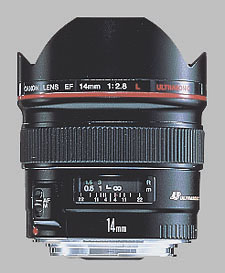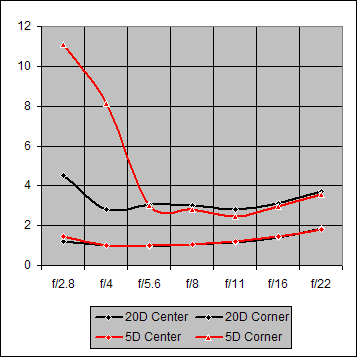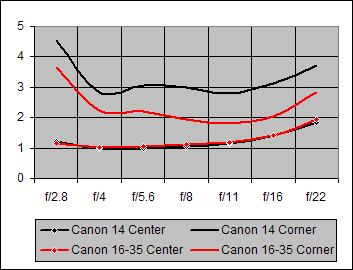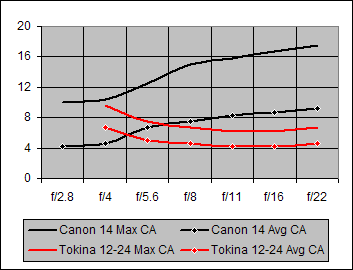| 14mm |
$1,200 average price |
|---|---|

|
|
Lab Test Results
Your purchases support this site
Buy the Canon EF 14mm f/2.8L USM
(From Canon lens literature) This ultra-wide-angle lens has the shortest focal length in the L-series. Element 2 is an Aspherical lens to correct distortion. Other aberrations such as astigmatism are also corrected, resulting in ideal image quality. The lens has a fixed, petal-type hood and a gelatin filter holder at the rear.
Test Notes, Canon 14mm f/2.8L USM
by Jim Tanner
Even on a sub-frame camera, a focal length of 14mm gives useful wide angle coverage, while on a full-frame camera it's close to as wide as you can get. Combined with a f/2.8 maximum aperture, this could make the Canon 14mm f/2.8L lens an in-demand optic, but we found that its corner sharpness suffered somewhat in our testing, and its Chromatic Aberration levels were a good bit higher than average.
Be sure to check out the Blur Index Viewer shown to the right of this report, which shows the detailed blur performance of this lens on our sub-frame Canon EOS-20D body. The first plot in the viewer (f/2.8) reveals a relatively sharp center and very soft corners. As you move the aperture slider to show performance at smaller apertures, you'll see that the center remains sharp (best sharpness comes at about f/5.6) and the corners, while improving, remain rather soft. The Full Frame (5D) Blur Sequencer (see the Full Frame Results tab above) reveals even softer corners on the 5D, a result of the larger sensor capturing image data even farther from the center. These observations will be expanded upon in the two sections (Center Sharpness, Corner Sharpness) immediately below.
Center Sharpness

Figure 1. Center Sharpness for Canon 14mm f/2.8L on Canon 20D and Canon 5D
Center Sharpness for the Canon 14mm f/2.8 on both the Canon 20D and 5D are shown to be essentially identical in Figure 1. This, of course, is not surprising because we use a multiplicative Scaling Factor of 1.34 to adjust the 5D results to best agree with the 20D measurements, compensating for the larger pixels on the 5D. Using DxO's own interpretation of their blur numbers, the center portions of the images are "Sharp" in the f/2.8-f/16 range. Diffraction degradation reduces the f/22 centers to a level of "Slight Blur" for this lens. All in all, the Center Sharpness for the Canon 14mm f/2.8 lens is very good.
Corner Sharpness

Figure 2. Center and Corner Sharpness for Canon 14mm f/2.8L on Canon 20D and Canon 5D
While Center Sharpness is good news for the Canon 14mm f/2.8, Corner Sharpness is decidedly not. Figure 2 shows this only too well. At f/2.8 and f/4, the performance on the 5D is miserable, at best. Performance on the 20D at f/2.8 is in the "Strong Blur" DxO classification. From f/4 on, Corner Sharpness on both bodies is "Slight Blur" to "Visible Blur" range. The Corner Sharpness for the Canon 14mm f/2.8 is poor.
Chromatic Aberration

Figure 3. Maximum and Average Chromatic Aberration for Canon 14mm f/2.8L on 20D and 5D
More bad news! Extremely high CA (Max and Avg) values for the Canon 14mm on the 20D. And while the 5D values are better, they are really too high as well. The Canon 14mm f/2.8 lens exhibits poor Chromatic Aberration performance.
Shading ("Vignetting")

Figure 4. Shading ("Vignetting") for the Canon 14mm f/2.8L on Canon 20D and Canon 5D
Shading performance by the Canon 14mm on the 20D is quite acceptable from f/4 on. The larger sensor of the Canon 5D reveals some pretty extreme shading for the wider apertures and relatively high shading for the remainder of the aperture spectrum. The Shading performance by the Canon 14mm f/2.8 is average/acceptable on sub-frame bodies, very high with full-frame sensors.
Distortion
|
Distortion for Canon 14mm f/2.8L
|
20D
|
5D
|
|
Maximum Distortion
|
0.43
|
0.49
|
|
Average Distortion
|
0.29
|
0.28
|
Surprisingly, the Distortion performance for the Canon 14mm lens is essentially the same on both sub-frame and full-frame bodies. While these values represent distortion that is perceptible to the average viewer, they are probably about average for lenses of this short focal length. The Distortion performance by the Canon 14mm f/2.8 receives an "Average" rating.
AF Operation
The Canon 14mm f/2.8 auto focuses quietly and relatively rapidly from a lens-to-target closest-focus distance of about 10cm to infinity. At closest focus, the image area spans a horizontal distance of 22 cm on a sub-frame 1.6x crop-factor body like the EOS-20D. The Manual Focus ring is comfortably wide and works very smoothly. Manual Focus works in the AF mode. The AF operation of the Canon 14mm f/2.8 earns an "Excellent" rating.
Build and Quality
While the Canon 14mm f/2.8L has the solid feel expected of an "L" lens, its balance on both bodies was quite good. The lens/body combination was well-balanced, the combination not feeling overly front-heavy as is sometimes the case with large lenses. The lens has a built-in hood to protect the bulging front element required for full-frame coverage at 14mm and f/2.8. A slide-on metal lens cap is quite functional; and because of its size, is perhaps harder to lose than the typical lens cap. The Canon 14mm f/2.8 is well-built quality lens.
Comparisons With Other Lenses
We will compare the Canon 14mm f/2.8L's performance with that of its Nikon counterpart, two excellent wide-angle Canon zooms, a Tamron wide-angle zoom, and a wide-angle zoom by Tokina. (Few readers would be likely to face a direct choice between the Canon and Nikon lenses, but we include that analysis for those interested in that sort of cross-platform comparison.) At the end of the line identifying each of these lenses, we show a typical street-value price to compare to the $1800 price for the Canon 14mm f/2.8L. In these tests, the Nikon 14mm f/2.8 was on the Nikon D200 body while the other lenses were all mounted on the Canon 20D.

Figure 5. Center and Corner Sharpness for Canon 14mm and Nikon 14mm
The Center Sharpness curves of Figure 5 for the Canon 14mm f/2.8L and its counterpart, the Nikon 14mm f/2.8 are essentially identical. While the Corner Sharpness for each lens is not very good, the Canon does better in the mid-range f/4-f/8 range.

Figure 6. Maximum and Average Chromatic Aberration for Canon 14mm and Nikon 14mm
Figure 6 reveals that the Nikon 14mm f/2.8 clearly outperforms the Canon 14mm f/2.8 in the Chromatic Aberration tests. By chance, the Average CA performance by the Canon is almost identical to the Maximum CA performance by the Nikon.

Figure 7. Shading ("Vignetting") for Canon 14mm and Nikon 14mm
The Shading graphs of Figure 7 indicate that the Nikon 14mm f/2.8 values are about three times (worse) than those of the Canon.
Canon EF 16-35mm f/2.8L USM $1370
This is the original version of this lens, which we tested some time ago. Canon recently (early 2007) announced an upgraded version, the Canon EF 16-35mm f/2.8L II, which we haven't tested yet, as of this writing in late May, 2007. A design goal of the new lens was to increase sharpness on digital bodies, so it'll be interesting to see how it performs. Meanwhile, here's a comparison between the Canon 14mm f/2.8L and the original 16-35mm f/2.8L:

Figure 8. Center and Corner Sharpness for Canon 14mm and Canon 16-35mm @ 16mm
The Center Sharpness curves of Figure 8 for the Canon 14mm and the Canon 16-35 @16mm indicate very good, essentially identical Center Sharpness performances by the two lenses. This is not the case for Corner Sharpness. The Canon 16-35mm f/2.8L outperforms the Canon 14mm f/2.8L by about one Blur Unit over the entire f/2.8-f/22 spectrum. Remember that DxO asserts that a blur factor difference of one unit is just barely perceptible by a typical observer.

Figure 9. Maximum and Average Chromatic Aberration for Canon 14mm and Canon 16-35mm @ 16mm
It is probably not surprising that the Canon 16-35mm f/2.8L significantly betters the Canon 14mm f/2.8L in the Chromatic Aberration tests. Again, the Average CA performance of the Canon 14mm is about equal to the Maximum CA performance of its competitor, in this case the Canon 16-35mm.

Figure 10. Shading ("Vignetting") for Canon 14mm and Canon 16-35mm @ 16mm
The Shading performances by the Canon 14mm and the Canon 16-35mm lenses are essentially identical except at f/2.8, where the "wide open" shading by the Canon 14mm is significantly worse than that of the Canon 16-35mm.
Canon EF-S 10-22mm f/3.5-4.5 USM $690
(Note in this comparison that the 10-22m is an EF-S lens, which means it only covers the reduced frame size of 1.6x crop-factor cameras like the EOS-20D, 30D, Rebel XTi, etc.)

Figure 11.Center and Corner Sharpness for Canon 14mm and Canon 10-22mm @ 14mm
Again, the Center Sharpness performances by the Canon 14mm and its competitor, the Canon 10-22mm are essentially identical. And again, the competitor's Corner Sharpness performance is significantly better by about one Blur Unit across the aperture spectrum.

Figure 12. Maximum and Average Chromatic Aberration for Canon 14mm and Canon 10-22mm @ 14mm
CA performance by the Canon 10-22mm lens is significantly better than that of the very poor CA exhibited by the Canon 14mm f/2.8.

Figure 13. Shading ("Vignetting") for Canon 14mm and Canon 10-22mm @ 14mm
The Canon 14mm f/2.8L easily wins the Shading duel with the Canon 10-22mm, although the performance by the latter isn't terrible. (Overall, the 10-22mm f/4 is a real jewel of a little lens, really great for ultra-wide shooting on sub-frame bodies.)

Figure 14. Center and Corner Sharpness for Canon 14mm and Tamron 11-18mm @ 15mm
While the Tamron 11-18mm @ 15mm does not reach down to f/2.8 or even f/4, its Center Sharpness performance over the f/5.6-f/16 aperture range is very nearly the same as that of the Canon 14mm. At f/22, the Tamron is noticeably less sharp than the Canon. Corner Sharpness with the Tamron lens is significantly better than that of the Canon.

Figure 15. Maximum and Average Chromatic Aberration for Canon 14mm and Tamron 11-18mm @ 15mm
Once again, the Canon 14mm f/2.8L is completely outperformed in Chromatic Aberration performance by yet another lens, the Tamron 11-18mm f/4.5-5.6.

Figure 16. Shading ("Vignetting") for Canon 14mm and Tamron 11-18mm @ 15mm
The Shading performance by the Canon 14mm and the Tamron 11-18mm are essentially the same over the f/5.6-22 range where they can be compared.

Figure 17. Center and Corner Sharpness for Canon 14mm and Tokina 12-24mm @ 15mm
Over the f/4-22 aperture range where the Canon 14mm and the Tokina 12-24mm @ 15mmcan be compared, the two lenses have essentially identical Center Sharpness performance. The Tokina 12-24mm @ 15mm, however, significantly outperforms the Canon 14mm in the Corner Sharpness test.

Figure 18. Maximum and Average Chromatic Aberration for Canon 14mm and Tokina 12-24mm @ 15mm
At f/4, the Canon 14mm and the Tokina 12-24mm @15mm have very similar CA performances. But, thereafter, the Tokina significantly outperforms the Canon 14mm in the Chromatic Aberration duel.

Figure 19. Shading ("Vignetting") for Canon 14mm and Tokina 12-24mm @ 15mm
Over the f/4-22 aperture range where the Canon 14mm and Tokina12-24mm @ 15mm lenses can be compared, these two lenses have essentially identical Shading performances.
Distortion Comparison
| Distortion | Maximum | Average | Rank |
| Canon 14mm |
0.43
|
0.29
|
4
|
| Nikon 14mm |
0.65
|
0.43
|
5
|
| Canon 16-35mm |
0.83
|
0.47
|
6
|
| Canon 10-22mm |
0.11
|
0.07
|
1
|
| Tamron 11-18mm |
0.35
|
0.23
|
3
|
| Tokina 12-24mm |
0.31
|
0.11
|
2
|
Table 2 presents the Maximum and Average Distortion values for the six lenses discussed in this section. The Canon 10-22mm @ 14mm is the clear winner in the Distortion tests, while the Canon 16-35mm @ 16mm has the poorest Distortion performance. The subject of this report, the Canon 14mm f/2.8L is a disappointing fourth.
Other Comparable Lenses (not yet tested)
Three other lenses that might be considered as competitors to the Canon 14mm f/2.8L are:
Tamron 14mm f/2.8 Aspherical IF SP AF $1099
Sigma 14mm f/2.8 EX Aspherical HSM $899
Canon EF 16-35mm f/2.8L II USM $1599
Unfortunately, we have not yet tested these lenses. We hope to do so in the (reasonably) near future.
Conclusions
The Canon 14mm f/2.8L is a sturdy smooth-functioning lens that exhibits very good Center Sharpness across its f/2.8-f/22 aperture spectrum on both full-frame and sub-frame bodies. Corner Sharpness is, at best, mediocre; Chromatic Aberration is quite poor; Shading is reasonably good; and Distortion is average. Here's a summary of how the Canon 14mm f/2.8L compares with each of the other lenses discussed, using an arbitrary subjective scale as described below:
| Compared to EF 14mm f/2.8 |
Cen
|
Cor
|
CA
|
Shad
|
Dist
|
Total
|
|
Nikon 14
|
0
|
+1
|
-2
|
+2
|
+1
|
+2
|
|
Canon 16-35
|
0
|
-1
|
-2
|
-1
|
+2
|
-2
|
|
Canon 10-22
|
0
|
-2
|
-2
|
+2
|
-2
|
-4
|
|
Tamron 11-18
|
0
|
-1
|
-2
|
0
|
-1
|
-4
|
|
Tokina 12-24
|
0
|
-2
|
-2
|
0
|
-1
|
-5
|
|
Total
|
0
|
-5
|
-10
|
+3
|
-1
|
|
In Table 3 where we summarize the Comparison Section, the (subjective) values in the cells have the following meanings:
|
+2
|
Better Performance by Canon 14/2.8
|
|
+1
|
Slightly better performance by Canon 14/2.8
|
|
0
|
No significant difference
|
|
-1
|
Slightly worse performance by Canon 14/2.8
|
|
-2
|
Worse performance by Canon 14/2.8
|
Interestingly, the Canon 14mm f/2.8L ($1800) would appear to outperform (by a slim margin) only the Nikon 14mm f/2.8 ($1420). Both of these rather expensive primes are seemingly outpaced by each of the four zooms we included in this report. The Canon 14mm, Nikon 14mm, and the Canon 16-35mm ($1370) lenses are the only f/2.8 lenses of the six included in this report though, so it may be that their poor showings indicate the difficulty of producing a wide-angle low-aperture lens. Whatever, the overall performance of the Canon 14mm f/2.8L is a bit of a disappointment (as was that of the Nikon 14mm f/2.8).
Full-Frame Test Notes:
As is generally the case, corner sharpness and shading take a hit in moving from a sub-frame to a full-frame body. At the same time though, the larger pixels of our 5D test bed mean that the 14/2.8's Chromatic Aberration goes from terrible to only moderately bad. (Note that smaller pixels on a full-frame camera would boost the CA back up again, though.) Shading (vignetting) is particularly problematic though, literally off the chart on our standard graph, which tops out at 1.25 EV. The actual measured value was 1.9 EV, almost two full stops of light falloff in the corners of the frame. Somewhat surprisingly though, distortion was only a little higher on the 5D body. Shading is easily corrected in software (for that matter, so is distortion these days), so the 14/2.8 may actually make a fairly decent lens for super wide-angle photography on full-frame cameras.
Canon EF 14mm f/2.8L USM
Your purchases support this site
Buy the Canon EF 14mm f/2.8L USM
Canon EF 14mm f/2.8L USM User Reviews
-
good construccionbulky and not very good picture-quality
I made a very long test with this Canon L 14. Not worth even 1000$. The only good fact is the solid construccion. The pricetag of 2000$ is a bad joke. Strong resolution-fall-off at the borders, only the center is quiet good. Colours are a bit washed out and flare is a real big problem. Distortion is only acceptable and you will see some cornershading. May be this lens is made for film, but on digital its realy nothing special. There are a lot of good L-lenses around, but the L 14 is not worth a deeper look! If you like extrem wideangels you can buy the very good prime Sigma EX DG 14 (550$) or the fantastic zoom Tokina 12-24 PRO AX (450$).
reviewed May 17th, 2007 -
W-I-D-Eimage quality not right up there
This is one of the widest rectilinear lenses you can get, and with L-series quality to boot. However, it's not quite on par as other L lenses (maybe it needs an updated version).
reviewed January 5th, 2007
For it's price, though, I'd recommend the 16-35/2.8L zoom - sure it's not as wide, but optically better and you get the zoom to0. -
size, focal length, built in hood, wide aperture, speed of focusflare, goofy lens cap
I really like this lens. It's REALLY fast & accurate to focus. It's 2.8 aperture is very usefull in dark environments.
reviewed December 28th, 2006
It gets pretty soft in the corners on a full frame wide open. But on a cropped sensor, it's a very useful 22mm equivalent, and sharp to boot.
I keep flip-flopping between keeping this on my 20d, or the 10-22. They are roughly the same size. The 14mm is brighter, but the 10-22 is less prone to flare & has the flexibility of zoom (and is less expensive).
I dislike the large metal lens cap. It doesn't fasten to the lens very well. -
really, really widea flare monster
This is my least favorite Canon lens. When you need a really wide lens (on full frame) this is it. On cropped bodies, the 10-22 is probably a better choice. But my copy flares almost uncontrollably and is not terribly sharp. (My 15mm fisheye has better flare control and I think it is sharper, but it obviously has the FE thing going.) I recommend this lens for people who really need a wide angle and are prepared to deal with its foibles. But I think a lot of people will be disappointed with it. jack
reviewed December 8th, 2006 (purchased for $1,200)







